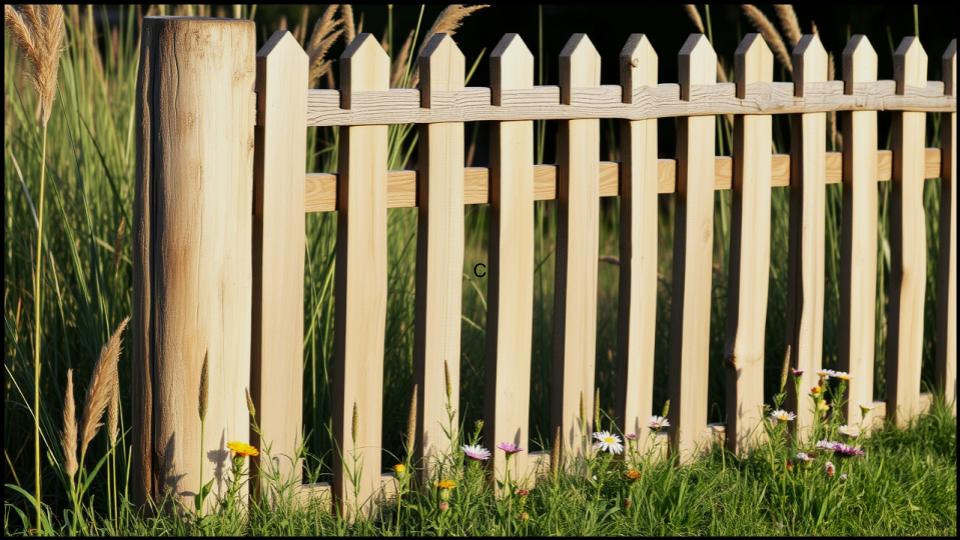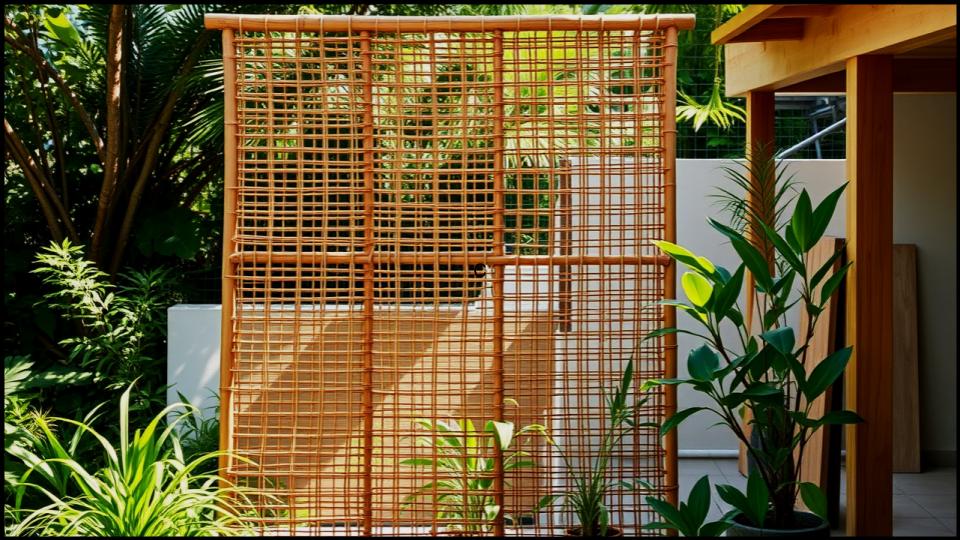
A garden fence is so much more than a simple boundary line. All too often, we see it as a purely utilitarian feature—something to mark property, keep the dog in, or deter deer. But a well-chosen fence is one of the most significant design elements in your entire landscape. It’s the backdrop to your prize-winning roses, the frame for your vegetable patch, and the first architectural element that greets you and your guests. These garden fence ideas will encourage you to think beyond the ordinary and transform a practical necessity into a stunning piece of outdoor decor.
Let’s explore how you can create a boundary that is as beautiful as the garden it protects.
Key Insights at a Glance
Here’s what you need to know to choose the perfect decorative garden fence:
- Marry Form and Function: The best fences solve a problem (like privacy) while also enhancing your garden’s aesthetic.
- Complement Your Home’s Architecture: Your fence should feel like a natural extension of your home, whether it’s a rustic farmhouse or a sleek, modern build.
- Think in Layers: Use your fence as a backdrop for climbing plants, espaliered trees, or strategically placed garden art to create depth and interest.
- Don’t Underestimate Materials: The material you choose—from warm wood to cool metal—sets the entire tone for your outdoor space.
Classic Fences with Timeless Appeal
These styles have endured for a reason. They integrate seamlessly into traditional garden designs and bring a sense of history and charm to any property.
The quintessential White Picket Fence
The white picket fence is an American icon, evoking images of charming cottages and vibrant flower beds. To keep it feeling fresh and not cliché, consider playing with the proportions. A shorter, 3-foot fence is perfect for defining a front-yard flower garden without blocking the view, while wider pickets or a scalloped top can add a touch of custom elegance. In my own garden, I’ve found that pairing a classic picket fence with billowing masses of lavender and catmint creates a delightful contrast between formal structure and informal planting.
Elegant Wrought Iron
For a touch of formality and old-world grace, nothing compares to wrought iron. Its slender profile provides security and definition without obstructing views, making it ideal for showcasing a beautiful landscape. While true, custom-forged iron is an investment, you can find high-quality aluminum or steel versions that offer a similar look with less maintenance. A decorative garden fence like this is the perfect partner for formal rose gardens or topiaries.
Rustic Split-Rail
Evoking the pastoral beauty of the countryside, a split-rail or post-and-rail fence is an excellent, low-impact choice for larger properties. It creates a clear boundary with a wonderfully open and airy feel. It’s a natural fit for rustic, farmhouse, or prairie-style planting schemes. For a bit more containment, you can easily add wire mesh to the inside, which is a common solution I recommend to clients who love the look but need to keep pets safely enclosed.

Natural Materials for an Organic Feel
Connecting your fence to the natural world through materials creates a cohesive and tranquil garden environment.
Woven Wattle Fencing
One of my absolute favorite techniques for an informal, textural look is wattle fencing. Made from weaving flexible young branches (traditionally willow or hazel) between sturdy upright posts, wattle is a time-honored craft that feels both ancient and contemporary. It’s perfect for sectioning off a kitchen garden or creating a whimsical screen. You can build them yourself for a truly sustainable project, a process detailed by the Royal Horticultural Society.
The Living Fence or Hedge
The ultimate eco-friendly fence is one that’s alive. A formal, clipped hedge of boxwood (Buxus), yew (Taxus), or hornbeam (Carpinus) creates a dense, green wall that provides year-round structure. For a more informal look, a flowering hedge of forsythia, lilac, or rugosa roses offers seasonal beauty and a wonderful habitat for birds and pollinators. A living garden privacy fence requires patience and maintenance, but the reward is a boundary that changes with the seasons and truly becomes part of your garden.
Sustainable Bamboo Screens
For a hint of the tropics and a wonderfully sustainable option, consider rolled bamboo fencing. It can be easily attached to an existing chain-link or post fence to instantly mask an unattractive view and create a serene, spa-like atmosphere. Choose a high-quality, pre-assembled panel for the best look and longevity. It’s an incredibly effective and budget-friendly way to achieve privacy and style.

Enduring Stacked Stone Walls
While technically a wall, a low-stacked stone structure serves the same purpose as a fence with unmatched permanence and texture. Whether you opt for a mortar-free dry-stack wall or a more formal mortared one, stone connects the garden to the earth itself. The crevices are perfect for tucking in alpine plants like creeping thyme or sedum, softening the hardscape and turning the wall into a vertical rock garden. A study from the University of Georgia Extension highlights how these structures can also help manage slope and water runoff, blending beauty with practicality.
Modern Fence Design for the Contemporary Home
If your home’s architecture is clean and contemporary, your fence should follow suit. These ideas emphasize strong lines, mixed materials, and minimalist aesthetics.
The Sleek Horizontal Slat Fence
Perhaps the most popular modern fence design right now is the horizontal slat fence. Long, clean lines of wood (like cedar or ipe) create a sophisticated and stylish screen that makes a space feel wider. You can play with the spacing between the slats—wider gaps feel more open, while narrow gaps provide near-total privacy. This style is a fantastic backdrop that makes vibrant green foliage pop.

Industrial-Chic Gabion Walls
A gabion wall is a fantastic way to introduce bold, industrial texture. These are essentially wire mesh cages filled with rocks, but the concept is endlessly versatile. You can fill them with smooth river stones for a polished look or jagged, angular rocks for a more rugged feel. A common mistake I see is over-filling the cages, which can cause them to bulge; a properly filled gabion should be packed tightly but not to the point of distortion.
Corrugated Metal Panels
Don’t underestimate the power of corrugated metal. Once relegated to utilitarian sheds, it’s now being used in landscape design for its texture, durability, and sleek profile. You can use standard galvanized steel for a bright, industrial look, or opt for Corten steel, which develops a stable, beautiful rust-colored patina over time. It’s incredibly low-maintenance and makes a striking statement.
Frosted Glass or Polycarbonate
For a garden privacy fence that doesn’t feel like a heavy wall, frosted glass or polycarbonate panels are a brilliant solution. They offer visual screening while still allowing light to filter through, preventing an area from feeling dark or closed-in. Framed in dark metal or warm wood, these panels feel airy, elegant, and decidedly high-end.
Creative & Upcycled Garden Fence Ideas
For the gardener who loves a project and a touch of the unexpected, these creative ideas turn salvaged materials into one-of-a-kind features.
Repurposed Shutters and Doors
Old louvered shutters or paneled doors can be hinged together to create a charming, shabby-chic screen. A fresh coat of paint in a bold, unexpected color—a vibrant turquoise or sunny yellow—can turn it into a fantastic focal point. This is a perfect way to screen off compost bins or air conditioning units with a bit of personality.
Welded Wire or “Hog Wire” Panels
For a look that’s both rustic and minimalist, framed wire mesh panels are a superb choice. Often called hog wire, these sturdy grids are fantastic for supporting climbing plants. Plant a fast-growing annual vine like moonflower or a perennial clematis at the base, and by mid-summer, you’ll have a living wall of flowers and foliage on a barely-there structure. It’s one of the best garden fence ideas for maintaining an open feel while still creating division.
Budget-Friendly Pallet Fence
With a bit of elbow grease, discarded shipping pallets can be disassembled and rebuilt into a rustic and surprisingly stylish fence. Be sure to select pallets that are heat-treated (marked with “HT”) rather than chemically treated, especially if the fence will be near an edible garden. A good sanding and a coat of exterior stain or paint will elevate the look from scrap to chic.
Artistic Bottle Wall
For the truly adventurous and artistic gardener, a bottle wall fence is a showstopper. By setting colorful glass bottles into a mortar or cob frame, you can create a structure that glows like stained glass when the sun hits it. It’s a significant undertaking but results in a deeply personal and beautiful piece of functional art for your garden.

Your Fence, Your Garden’s Signature
Choosing a fence is an opportunity to make a statement and infuse your personality into your garden’s design. Whether you opt for the enduring charm of a picket fence, the clean lines of a modern screen, or the creative flair of a repurposed material, think of it as the signature on your landscape masterpiece. The right fence doesn’t just create a boundary; it creates a destination. Now you’re ready to choose a design that will bring you joy for years to come.
Read More
The Surprising Benefits of Growing Catnip—and Exactly How to Do It Indoors or Outside
